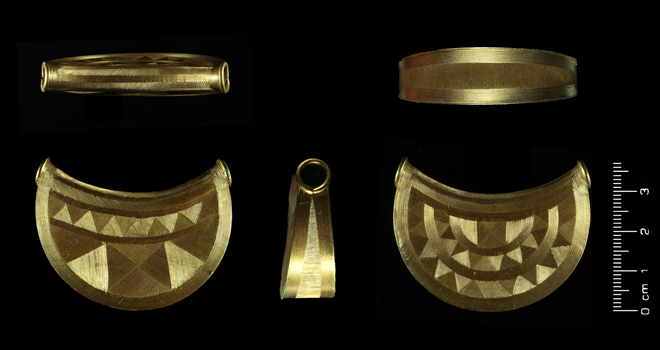Rare Bronze Age Gold Bulla declared as treasure
Mr John Ellery, HM Senior Coroner for Shropshire and Telford & Wrekin, held a Treasure inquest this morning (31/1/2019) into the discovery of this rare and important Bronze Age find reported via The British Museum’s Portable Antiquities Scheme during 2018.

The Bronze Age gold bulla found in Shropshire
The Shropshire Marches Bulla was recovered from an undisclosed findspot in Shropshire during May 2018 by a responsible metal detector user who wishes to remain anonymous.
The find was swiftly reported to the Finds Liaison Officer for Shropshire – Peter Reavill and to HM Coroner for Shropshire – Mr John Ellery as potential treasure. Information pertaining to the landowner and finder are being kept secret to protect the findspot and associated potential archaeological remains.
The finder of the bulla has described it as “the very best find of their detecting career – it’s simply mind-blowing.”
The discovery of this nationally important artefact has the potential of being one of the most significant pieces of Bronze Age gold metalwork ever discovered from the British Isles.
The artefact is known as a bulla (from the Latin for bubble) which is a hollow pendant suspended from a long-decorated gold tube. It is crescent in shape and wedged in profile. All surfaces are decorated with incised repeated geometric patterns. The gold plates are cut with opposing lines by a craftsman whose skill would have been almost unequalled in the period.
Peter Reavill, Finds Liaison Officer for Shropshire, said:
“The design is such that the play of light over the surface is what you see most, changing with angle and light moving and shimmering, dancing and ever different. This would have been enhanced in the period where it would have been stunning when viewed by firelight or in bright sunlight.”
The form of pendant is amazingly rare, with only one other direct parallel known. That example was discovered in the 18th century whilst cutting a canal on the River Irwell, Manchester. It was sold in 1806 and its whereabouts is not known. Six other broadly similar bullae are known from the northern part of the island of Ireland and all these examples are dated to the late Bronze Age (1000 – 750 BC).
Research led by Dr Neil Wilkin (curator of Neolithic and Bronze Age Collections at the British Museum) has shown that the Shropshire Marches bulla is hollow. It appears to contain a soil-like material, although currently it is unclear whether this material was originally part of the bulla or merely present as a result of burial. More analysis is pending. The bulla has been analysed by scientists at the Museum and has shown to be largely formed of thin sheet containing approximately 80% gold, the remainder of the alloy being silver and copper. Such alloys are consistent with metalwork created during the later part of the Bronze Age.
Dr. Wilkin, said:
“The significance and context of the bulla relates to this tradition of gold working excellence. The find reflects important connections between England, Wales and Ireland during the Late Bronze Age.”
A multi-agency research bid to investigate the archaeological landscape from which the bulla comes is currently being written by Historic England, Portable Antiquities Scheme, The British Museum and archaeological staff at Shropshire Council.
On hearing the evidence in relation to this find Mr. Ellery found that the artefact met the criteria laid out in the Treasure Act (1996) in that the find was more than 300 years old when found and is formed of precious metal in excess of 10% – as such he declared the find to be Treasure.
Now that the find has been officially declared treasure – the next stage is for it to be independently assessed by a governmental panel known as the Treasure Valuation Committee. They will find the market value of the bulla and a museum will be given the option to acquire it with the monies raised being shared jointly as a reward between the finder and landowner.
Archaeologists are keen to further research and study the find. Until a valuation has been reached it is difficult to know the future for the bulla. Shropshire Museum Service and staff at the British Museum are in high level discussions to ensure that it remains in the public domain and can be appreciated by as many people as possible.
Lezley Picton, Shropshire Council Cabinet member for culture and leisure, said:
“I’m really excited by this most recent archaeological find. It is yet another example of how the Portable Antiquities Scheme and responsible metal detecting is adding to our understanding of prehistoric Shropshire. In recent years, important finds like this have changed how we view the county’s past and improved our already important museum collections. I look forward to seeing how this remarkable object adds to this story.”
More information and images on the bulla can be found here:
Bulla: https://finds.org.uk/database/artefacts/record/id/902916
Image: https://finds.org.uk/database/images/image/id/1037310/recordtype/artefacts
(images may be reproduced and used with permission of British Museum’s Portable Antiquities Scheme).
For more information, please contact Peter Reavill – Finds Liaison Officer (Shropshire and Herefordshire) for the Portable Antiquities Scheme:
Email: peter.reavill@shropshire.gov.uk
Tel: 01743 25 4748
Web: http://finds.org.uk / Twitter: @FLO_Marches / @PeterReavill

